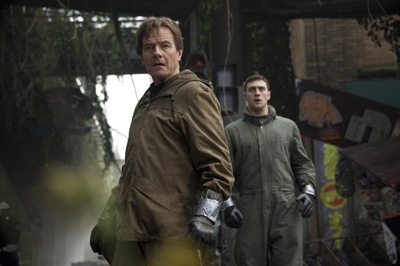Movie Review: Godzilla
By Matthew Huntley
May 22, 2014
BoxOfficeProphets.com

In many ways, yes, “Godzilla” is a traditional monster movie. It contains the obligatory violence and devastation; the widespread panic; the military intervention; the safe love story; etc. And of course, in this day and age, it’s padded with an inordinate amount of special effects.
But to our pleasant surprise, the filmmakers actually harness these qualities rather than simply toss them into the mix and have them spin around chaotically. Director Edwards and his team show a surprising amount of restraint and patience when it comes to shots of buildings toppling, the sea rising, people running around scared, and random things exploding. They seem to only include shots that are necessary to get the point across instead of overloading us with effects and sensation just to show off the film’s budget.
I actually checked my watch during the screening, and we don’t actually catch a glimpse of Godzilla himself until a good hour into it, and the movie is only two hours long. That alone should tell you something - that perhaps Godzilla isn’t so traditional after all. Monster movies are often too hasty to reveal the monster and then stick with him for the entire duration, as if that’s all we want to see. But even though Godzilla is the titular character, his screen time is limited, and that makes his presence all the more precious, if you will. We actually leave wanting more, which is so much better than wanting less.
In the tradition of the original Japanese film series that began in 1954, the movie is about an ancient, dragon-like creature, aptly named Godzilla, who formed from the Earth’s natural radiation in the north pacific. He was awakened during nuclear testing in the 1950s and then allegedly killed.
The movie opens in 1999, when two scientists from the clandestine Monarch Company, Dr. Serizawa (Ken Watanabe) and Dr. Graham (Sally Hawkins), are called to the Philippines to investigate a pair of giant, mysterious eggs that were recently uncovered in a quarry. Labeled MUTO (Massive Unidentified Terrestrial Organism), one of the eggs makes its way toward a nuclear power plant in Japan to feed off the radiation.
All of this is kept under wraps, but the power plant’s head engineer, Joe Brody (Bryan Cranston, whose character here isn’t all that different from the one he plays on Breaking Bad), is convinced the recent seismic activity around the area isn’t the result of an earthquake. He sends his fellow-scientist wife (Juliette Binoche) to investigate, but a sudden electro-magnetic pulse causes the plant to explode.
Fifteen years later, Joe’s son Ford (Aaron Taylor-Johnson) is an explosive ordinance disposal officer in the U.S. Navy and married to Elle (Elizabeth Olsen). They live in San Francisco with a son of their own, and just when Ford returns home from active duty, he’s called to Japan to bail his father out of jail. Joe continues to trespass into the restricted area that was supposedly contaminated by the explosion from over a decade ago, but he still believes there was a cover-up.
He would be right, and now those same giant eggs from before - one of which still resides at the nuclear plant in Japan, the other in a desert outside Las Vegas - are about to hatch. Their birth, in turn, awakens Godzilla, whom we’re told is the MUTO’s natural predator. Serizawa explains Godzilla is meant to kill them in order to maintain nature’s balance and that the beasts should simply be allowed to fight. Unfortunately for humans, that means being stuck in the middle of all hell breaking loose.
There’s nothing overly original about the plot of Godzilla - it has the same basic structure as most monster movies, although it was a refreshing twist that Godzilla is made out to be an ally of mankind instead of an enemy.
The movie’s excitement and value stem not from what’s told to us, but how it’s told to us. Edwards is a natural born filmmaker in that he possesses a keen vision and impeccable sense of timing. He knows what to show us with his camera and for how long, which is crucial for a movie like this. He even teases us in the way he reveals Godzilla, first in a clever opening sequence in which the facts and figures of the nuclear testing surround the credits, and then in the smaller details like Godzilla’s spikes surfacing from the ocean, or his foot suddenly pounding on an airport tarmac. Edwards waits, and when the time comes to finally tilt up and show Godzilla in all his glory, the result is truly epic and spectacular.
But the movie doesn’t stop there. I counted at least 10 more unforgettable shots when my eyes were simply captivated by what was happening on-screen, right down to something as supposedly routine as a fight between the monsters. With the help of top-notch special effects, the filmmakers generate real tension and the sheer scope of the movie and the way all of its parts come together seamlessly practically leave us speechless.
It surprises me to write this, but Godzilla exemplifies the pure craft of filmmaking and how the cinema can still do wonders as a visual storytelling medium. To be fair, it does indulge in patronizing the audience a tad too much in the end, but the bottom line is this blockbuster has been made with a great amount of attention and care, and we’re filled with nothing but awe and admiration.